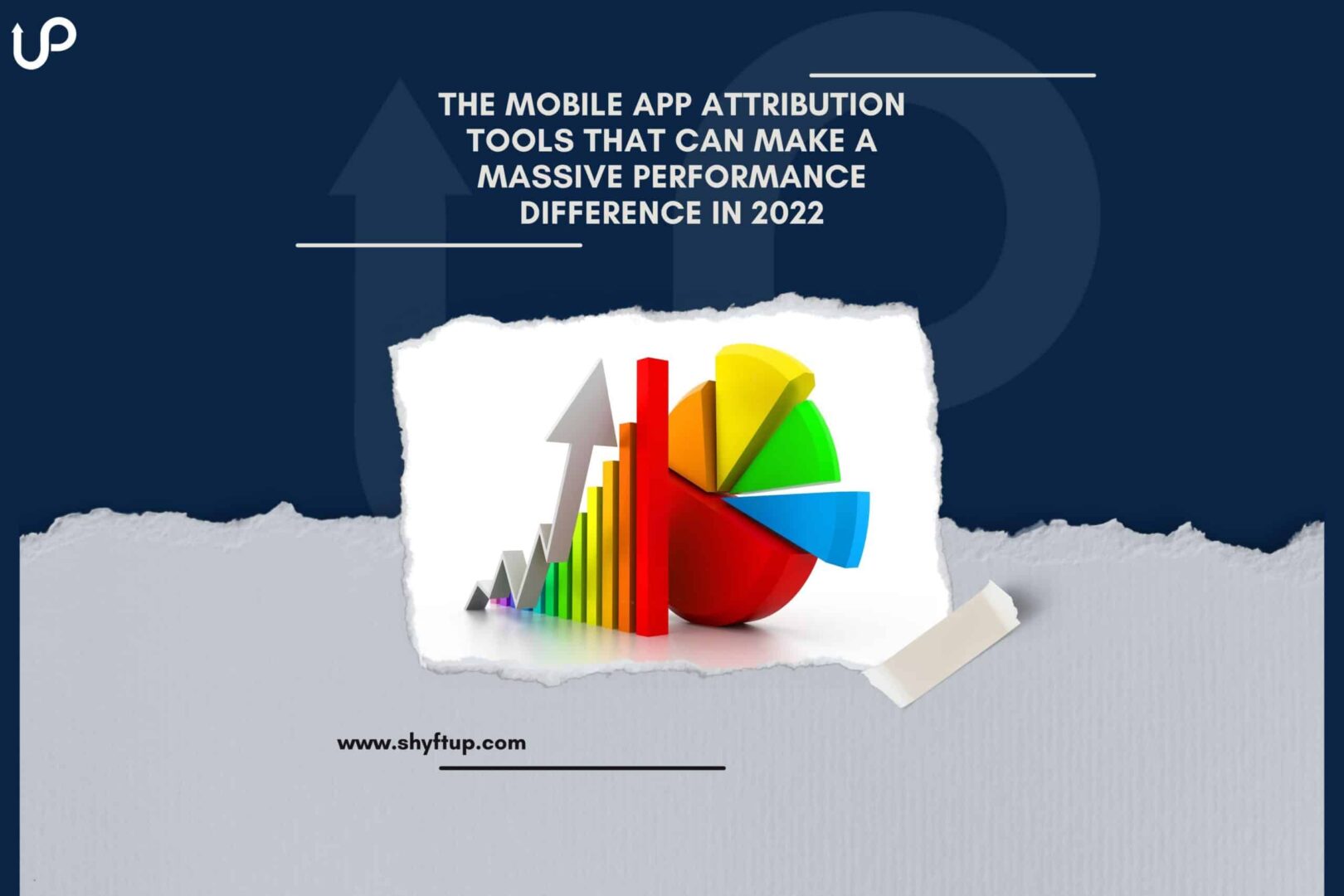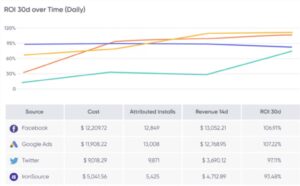
The Mobile App Attribution Tools in 2022
Introduction
Every developer should appreciate the crucial impact of app analytics and mobile app attribution tracking on their ultimate market performance. Indeed, there’s no substitute for knowing who your users are, where they come from, and precision app tracking their customers’ journey from end to end. Data and the metrics that crucially signify the success or failure of marketing activities in and around the app stores converge on the mobile app attribution arena.
What is mobile app attribution?
Mobile app marketing attribution revolves around app installs combined with sustained marketing efforts like advertising campaigns. Cause and effect analysis relating to various activities enters the equation heavily whenever spending and budgets come under consideration. Nobody wants to waste money on actions that fall flat or fail to meet expectations. The attribution appeal is finding a provider that can connect app installs, events, and revenue to marketing initiatives. The objective, of course, is to invest more in ROI-centric programs by creating more downloads and in-app purchasing.
From another angle, the answer to “what is app attribution?” is this: It connects to marketers who want to know the ad creatives that break barriers with improved performance in real-time. It frequently means digging into:
- The bidding strategies that drive the highest “Return On Ad Spend” (ROAS).
- The ad networks and media sources that tie into your ROI objectives best.
A question frequently arises – “How different is mobile app attribution from web attribution?”
The answer is that while the principle is precisely the same for both, there’s no doubt that mobile attribution is considerably more complex. Web attribution traditionally uses verified methods for tracking a user, such as cookies (with a high level of sophistication), image pixel tags, and attaching custom parameters to the URL (e.g., UTM).
However, tracking on mobile is far more complicated outside the usual one-click methods (see more on this below). Overviewing the entire customer journey, touchpoint by touchpoint must overcome user identification challenges as customers move between the store and the final install. It’s the one massive reason mobile attribution works very differently versus web methods in the same space.
In summary: Top-class mobile marketers never waiver in their endeavors to test new mobile ad networks, expand their market segments, and grow profits. For this reason, nothing less than mobile app install attribution tools with complete network coverage will do.
A notable mobile attribution change in 2022
iOS (Apple) has warned app publishers that it doesn’t accept probabilistic attribution on iPhone and iPad under any circumstances, thus effectively banning it.
So what is Probabilistic attribution? A methodology that relies on collecting customer behavioral data alongside efforts to align it with other records. It’s a mobile attribution technique Android developers apply quite often (alongside deterministic methods) to identify any mobile device people use for browsing the internet (including laptops).
Conversely, Deterministic Attribution uses device IDs (not user behavior data) to pinpoint the same user, no matter their device. As a result, the match is 100% attribution accurate.
- Apple points out that “fingerprinting,” a probabilistic attribution technology, is illegal (and immoral) without signed-off user permission.
- As a result, all iOS mobile attribution depends on deterministic platforms, such as cookies on the web or advertising identifiers like GAID (Google’s Advertising ID) on Android.
- The net result is that developers on the App Store must focus on SKAdNetwork (a single-minded deterministic framework) that puts user privacy front and center of its configurations. In effect, it shifts the emphasis away from identifiers emerging from the users to those from the devices deployed.
On Google Play (Android apps), fingerprinting technology is still accessible but watch this space for any changes coming through fast these days.
It’s critical to understand that mobile attribution is a “now thing” looking forward, not delving into the past. In other words, predictability is everything. Developers want to know with reasonable certainty that if they implement marketing action A, B should reflect in the reliable metrics. Practical mobile attribution aims to evaluate cross-platform user journeys customized to the app’s needs, thus generating groundbreaking insights that assist marketing optimization.
One last word on probabilistic attribution for Android publishers still considering this system:
- Trying to match device data with user information generally delivers less accuracy and is, at best, a fill-in for unavailable deterministic identifiers.
- Moreover, users’ IP addresses change significantly more often than device identifiers, thus connecting to a shorter lookback versus deterministic attribution.
Different types of attribution models
As a developer looking for a mobile app attribution tool that works for you, the choices can be confusing. This article will help you navigate the space with a step-by-step overview. When prospects engage with you online, the attribution models follow the clicks. So, developers can select the best tools based on their click-centric approach.
For most of us, one click is enough, which boils down to choosing between First Click or Last Click Attribution models. How do they work? Their titles speak for themselves. The most popular last-click model is Apple’s SKAdNetwork, followed by the ones available as standard for Android. Nonetheless, both have view-through attribution capabilities (see below).
Attribution analysis can get significantly more complex when developers ask for formulas with more than one touchpoint. It means getting into click configurations available under the heading of Multi-Click Attribution. The latter appeals to marketers who believe that the customer journey (CJ) goes far beyond a single remote action (i.e., first or last click). Indeed, customer experience (CX) and CJ emerge from a series of connected touchpoints. Therefore, this school of thought rides on every click having some value toward creating customer conversion.
- On the one hand, it seems a reasonable proposition because every CJ relies on momentum. The latter translates into each click’s energy, moving customers to the next one until they convert. Sometimes, a click may collapse the CJ midstream, but that’s also valuable information. Why? Because knowing the defective touchpoints is as vital as the ones that keep things moving forward—healthy CJs result from erasing negativity wherever it impacts the CX.
- On the other hand, going deeper than one-click attribution is not the norm. It puts analytics pressure on the team to monitor CJs from beginning to end. Nonetheless, sophistication and complexity aren’t good reasons to dismiss viable options, especially if they come automated. So if this interests you, the arena divides down more into:
-
- View-through attribution – an option that allocates attribution to a customer simply looking at an ad without clicking on it.
- Linear attribution – where marketers weigh every touchpoint equally.
- Time-decay attribution – allocating ratings based on click timing (highest to the most recent clicks and low to the earlier ones).
Lower down; we’ll recommend multiple touchpoint tools that allow marketers to map out the CJ without hassle.
The main features developers expect from their effective attribution tools.
Here are the mobile attribution categories that remove all the noise and go to the heart of the matter.
- Customizing the Dashboard.
- Structuring reports to read the way the team understands data on:
- Uninstalls.
- New installs.
- Repeat customer usage
- Retargeting Attribution as changes take effect.
- Detecting fraudulent activity.
- Platform integrations converging on Google Ads, Apple Ads, and more.
- Pricing sensitivity.
Leading mobile marketers track the efficacy of their programs in the marketplace.
Aside from knowing your target audience profile and promotional tactics at one’s disposal, the critical quantitative app metrics must be at your fingertips. We’re talking about streaming data (such as installs and CPI) that can overwhelm team members attempting to interpret what they’re reading.
Therefore, you want to settle on a set of tools that will bolster your efforts to attain profitable and scalable growth for your apps. The deciding factor, in most cases, revolves around the app’s number of integrations. With the right tools in your corner, achieving total network coverage and thousands of attribution integrations is viable. You don’t only want to know where an install originated from. Think about customized KPIs connecting to every attribution tool in your armory, thus delivering:
- Unparalleled marketing performance analytics bedded in accurate, easy-to-read KPIs across all your ad networks contain the following features:
- Cross-platform attribution that covers almost unlimited interactions – even conversions emanating from non-mobile devices.
- Deep linking and deferred deep linking to support an unmatchable customer experience.
- Analytics that uncover every relevant campaign driver, such as cost accounting and ad monetization, for ROI insights attached to each marketing strategy.
- Counteracting mobile ad fraud with deterministic methodology.
You want a toolset that will save the company time and money by leveraging automation to collect campaign and attribution data seamlessly.
The best mobile attribution tools on the market today
1. Adjust
One always has to love a proposition that gives you more than you bargained for. That’s Adjust, in one compelling way: Its holistic solution offers customers mobile attribution with many added benefits. Top of a long list are the following:
- “Adjust Automate” allows marketers to control all campaigns on a single dashboard across numerous verticals like budget allocation, bid management, and more.
- The Adjust solutions include one that blocks fraudulent data from infiltrating an ecosystem, thus kicking the crime to the curb before it becomes a detection concern.
- Their proprietary technology under a subsidiary called “Unbotify” zones in specifically to eliminate in-app bot fraud.
- Its “audience builder” feature functions around audience re-engagement by focusing on the dynamics they’re currently interested in and updating the data accordingly. It segments network sources and avoids repetition of Comma-Separated Value files (i.e., CVSs).
- Adjust’s user-friendly dashboard tracks network performance by locking on to vital mobile app KPIs and finding in-app events.
- Versatility is the company’s meaningful competitive difference. As a result, Adjust relates to enterprise companies, SMBs, and even startups just starting to get traction.
2. Appsflyer
Appsflyer provides multi-touch attribution (see above) as a distinctive feature, elevating it above the standard models in Google Play and the App Store. It offers flexibility to focus on verticals such as retargeting attribution and configurable attribution windows, thus expanding insights in places that matter the most. In addition, this attribution brand offers you two free platforms:
- Starting from a zero base, it allows you to feel your way along the attribution path. It attaches to a “pay as you grow” theme, targeting SMBs with limited budgets.
- A basic version engages you and your users with limited interaction to start. Still, it presents the upside of expanding reports and dashboard customization as you progress.
- Note, there reaches a scalability point where premium versions kick in to put far-reaching attribution features on the table. For example, publishers can access exportable retention reports and cohort analyses. The latter integrates seamlessly with your app dev/marketing/managerial stack, configured in terms of:
- Country
- Source
Adjust versus Appsfly boils down to the interface that suits your team best. We suggest you try them both on the free versions, then choose one and scale up.
Source: Singular
3. Singular
Singular secures reliable reviews on their solutions, achieving better ROIs with “next-gen attribution, full-funnel marketing data, and best-in-class fraud prevention.” The software must have substantial substance to warrant that caliber of attention. The company demonstrates that it:
- Can connect data from almost any source, with automated methods proven to be error-free.
- Prides itself in a state-of-the-art fraud detection vertical, installed with prevention barriers simultaneously.
- Allows users to visualize ad assets and their vital metrics alongside one another.
- Lets stakeholders measure costs accurately and evaluate the ROI effects of their marketing programs.
- Has an impressive lineup of features that include:
- Marketing Analytics for cross-platform analysis.
- Reporting ad costs in one convenient report.
- Marketing metrics that are relevant and easy to read.
- Connecting revenue to expenses in a fast, meaningful manner.
4. Branch
Branch is making waves as an entrant in the attribution landscape that provides enterprise-grade solutions. The company focuses on holistic-centric effectiveness across all devices, channels, and platforms.” It strives and succeeds in competing with the leading brands by saving users hours of research. Moreover, it helps marketers identify crucial customer segments. From there, you can activate targeted audiences with useful metrics that measure and maximize marketing efforts across connected devices.
The outstanding Branch features are as follows:
- Robust mobile linking doesn’t flinch at engaging deep linked re-engagement ads, web, and email campaigns from any angle.
- Predictive modeling where universal identifiers such as IDFA and GAID are unworkable. It revolves around an industry-unique algorithm that seamlessly captures historical attributions for highly accurate results.
- Cross-Platform conversions guide users to develop unsurpassed customer experiences, no matter which channel they switch to. They cover all ad drivers such as customizable and targeted mobile banners, QR codes, app logins from any device, and more.
- Finding the missing marketing stack pieces in unison with all developers’ functional tools. It comes down to full integration of leading email providers, social platforms, data analytics tools, and ad networks on a one-time sync system.
So, not to confuse the story with too many alternatives, the single most important benefits of each suggested attribution platform are:
- Adjust if you want exceptional security and process speed.
- Appsflyer for user-friendliness and the most balanced services.
- Singular, if multi-touch attribution and anti-fraud are must-haves.
- Branch for enterprises demanding upgraded sophistication.
Conclusion
Our article has covered the attribution scenario from many angles to give developers like you a practical, hands-on feel for the subject. The latter plays into your long-term success by taking the cause and effect of marketing strategies to the nth degree. We suggest testing out our suggested models in real-time to appreciate how far the different features will take you.
Fill in gaps by talking to ShyftUp – a leading global User Acquisition Agency. They’ll help you decide your app portfolio’s iOS and Android attribution strategies. ShyftUp focuses on two primary services:
- App Store Optimization (ASO) – unleashing the power of organic user growth by creating boosted visibility on the app stores.
- Paid User Acquisition – to help you grow your user base by converting your paid marketing budget into real users, thus revenue. ShyftUp specializes in Apple Search Ads and Google UAC channels.
How does app install attribution work?
Using recommended tools enables marketers to understand how their ad creatives break barriers with improved performance in real-time. It also pinpoints defective touchpoints that disrupt the customer journey. Also, it connects app installs, events, and revenue to marketing initiatives.
Why is mobile attribution necessary?
It’s the ultimate cause-and-effect analysis that lets marketers know the strategies working in their favor.
What is an attribution provider?
One of the numerous options gives marketers the tools to implement a mobile attribution program.
What is mobile app attribution?
A question frequently arises - “How different is mobile app attribution from web attribution?”
A notable mobile attribution change in 2022
Different types of attribution models
The main features developers expect from their effective attribution tools.
Leading mobile marketers track the efficacy of their programs in the marketplace.


